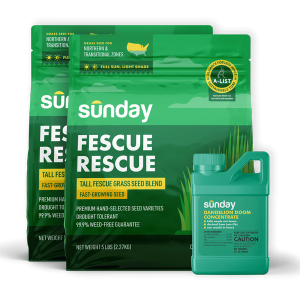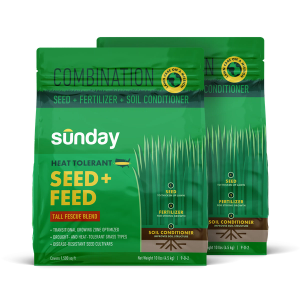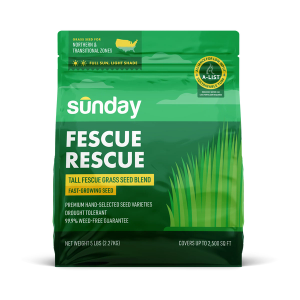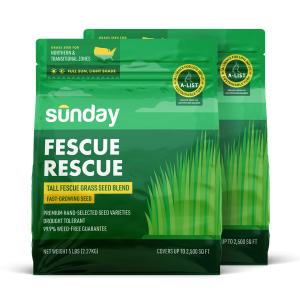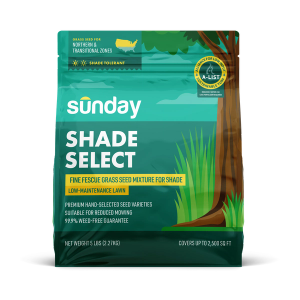How lawns can reduce water pollution
From rising water temperatures and oil spills to sediment runoff and improper waste disposal, water is at the forefront of global environmental concerns. When harsh pesticides are applied to lawns, they can also cause a host of environmental issues. But did you know that a healthy lawn can actually help protect our waterways?
Pollutants can go two places. They either enter the green filter or the gray funnel. The green filter is turf, plants, and other greenspaces (and the underlying soil) that actually filter and absorb runoff. The gray funnel is bare soil or impervious surfaces like pavement or cement that do little to absorb or slow down pollutants. At Sunday, we are working to grow better green filters with every beautiful backyard.
Where does water pollution come from?
In urban areas, the #1 cause of water pollution is industrial wastewater, plus faulty sewer and septic systems. Compounding this issue is the abundance of concrete, bare soil, and pavement. Erosion and sediment loss are another key issue in water pollution.
One of the greatest benefits of turf is that it reduces—and in some cases prevents—erosion. Exposed soil and the gray funnel only compound erosion. As a result, sediment runoff ends up in waterways causing additional pollution. When granular fertilizers, pesticides, and other harsh chemicals are incorrectly applied to lawns, they can also spread into waterways through the gray funnel. It doesn’t matter if these products are organic or synthetic—when improperly applied, they will contaminate waterways.
How do lawns improve water quality?
Natural spaces, lawns, and wild areas are a critical part of preserving water quality and reducing water pollution—especially in urban environments. Luckily, turf is a great natural filter. It can reduce sediment erosion by anywhere from 3–22x after large storms! Perennial turfgrasses have a dense, fibrous root system that is very efficient at filtering pollutants, including toxic metals and hydrocarbon compounds from oil, grease, and fuels. They also do a great job filtering household and industrial hazardous materials such as waste oils, paint thinners, and solvents, which makes them a great ally in preventing leaching into groundwater. Grassroots are very fine, thin, and fibrous, acting as mini cracks in soil that water can travel through to be absorbed. Not only does turf effectively filter run off and waste, but also it helps reduce run off by holding water.
Sunday Tip:
Just because turf makes a great filter, doesn’t mean we should allow any of these pollutants to hit our lawns. Be sure to always dispose of pesticides and household products properly.
How does Sunday help reduce water pollution?
Sunday is dedicated to supporting healthy waterways. From our products to our application practices and our 1% for the Planet partnerships, we are working to empower water-conscious lawn practices.
MLSN guidelines help us accurately deliver the exact nutrients that each individual lawn needs to grow thick, green, and healthy grass. That helps us reduce application rates, and prevent over-application altogether.
Every Sunday fertilizer shipment is timed to meet the climate and seasonal needs of each yard. This way we can avoid dormant periods, cut down on applications, and make sure that no nutrients go to waste. Every nutrient pouch contains liquid fertilizer instead of granules. Not only does this make it easier to apply, but also it cuts back on runoff since liquid applications are more precise.
Lucky Lawn reduces nutrient input because it introduces clover—a natural nitrogen fixer. We also limit the use of phosphorus, which can contribute to algae growth in waterways.
In fact, Lawn Starter is the only Sunday product that contains phosphorus. Intended primarily for new lawns, it is an important ingredient when used properly. But by keeping it out of other products, we ensure that no excess phosphorus is ever unnecessarily applied.
Sunday promotes the use of Sunday grass seed as a management tool to limit the use of chemicals in lawns. Many of our premium varieties have been evaluated by sustainable turfgrass programs including A-LIST. These studies validate that these varieties are lower maintenance and can withstand lower levels of fertilizer, water, and pesticides once established.
We use lawn soil tests to better understand your lawn ecosystem, ensuring that everyone gets the most out of their lawn with fewer inputs or applications.
We keep supplemental watering to a minimum, which prevents soil from becoming overly saturated and producing run-off. Not only does this reduce water use, but also it minimizes water pollution.
3 simple ways to rethink water use
- Use rain barrels
- Grow native plants
- Let your lawn go dormant
Water pollution affects us all
One of the best ways to reduce water pollution and conserve resources is to rethink the way we approach our lawns. Excessive application and harsh products only compound these issues. Instead, by working with nature rather than fighting against it, we can utilize more sustainable practices and keep our lawns, and our planet, green.
Cited sources
Homeowner's Guide to Protecting Water Quality and the Environment. Colorado
State University Extension.
Lawns & Water Pollution. University of Nebraska Lincoln.
The Role of Turfgrasses in Environmental Protection and Their Benefits to Humans. Journal of Environmental Quality.
Water Quality and Professional Lawn Care. North Carolina State University Extension.
What You Can Do: In Your Yard. United States Environmental Protection Agency.








